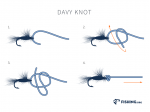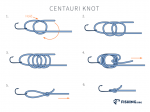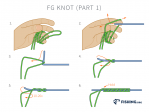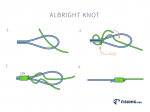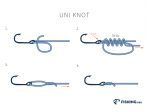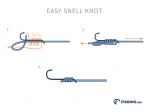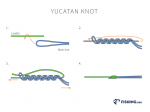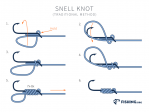Rapala Knot

How to Tie the Rapala Knot
The Rapala Knot will form a loop at the end of the line without the chance of it slipping. To get more action you can make a loop connection to a lure or fly. The Rapala Knot was named after the lure company that made this type of knot popular.
This type of knot was perfected by the Rapala brothers and it was originally created by the great fly master Lefty Kreh. Lefty Kreh improved on it by adding extra turns and the Rapala Brothers made it what it is today.
Step 2 & 3:
Step 4:
Most anglers feel that the bigger the fish they catch, the better. But it takes specific fishing gear to lure and reel such large fish out of the water. The Rapala knot is named after the lure company of the same name that popularized it as a method of joining their lures to monofilament lines.
Fishermen and women that search for a “big catch” need to use a non-slip loop knot that keeps the line secure and ready for river monsters.
Many use the Rapala Knot as it is ideal for Rapala lures. This fishing knot allows fishing lures and swivels to move around naturally to capture the attention of big fish. Many fly-fishers use this knot extensively in fly-fishing.
The Rapala Knot keeps the line secure, allowing you to be ready to reel in fish of all sizes.
The Non-Slip Knot
Since the Rapala Knot is a knot with a loop, it prevents it from slipping out. Anglers usually tie the knot directly to the lure and recommend it for use with Rapala lures. This includes linking the knot to your favorite Rapala crankbaits, like deep-diving crankbait, lipless crankbaits, swimbait, shallow divers, and jerk bait.
The reason to use it with Rapala lures is that it provides a loop that allows lures to move naturally and without interference. It gives it a realistic look, which attracts large fish.
The Rapala Knot is not only perfect for gaining the attention of big fish, but it is also strong enough to reel them in. It keeps most of the fishing line secure.
And when fly-fishing or big fish catching is the strength anglers want and need, this knot provides.
The knot makes it possible for the force to pass the loop because of the wrap in the center. It forms a loop at the end of the line, lessening the chance of the knot slipping off the main line.
How to Tie a Rapala Knot
Although the Rapala brothers perfected the Rapala Loop Knot, the great fly master Lefty Kreh initially created it.
If you want to try knot tying the Rapala Knot, follow these instructions:
- Tie a loose overhead knot before feeding the tag that ends through the hook eye and then back through the overhand knot.
- Make three turns around the standing line before bringing back the tag that ends through the overhand knot.
- Pass the tag end through the loop.
- Moisten the line before you pull on the standing line while you hold on to the tag end. Keep the tagline close to the knot.
- Pull-on both the lines to form a nice tight knot that will not slip. Also, be sure to leave enough loops, so it does not grip the lure.
Conclusion
After creating and using a Rapala Knot for the first time, you will want to keep tossing it out into your favorite saltwater fishing spots. It is time to reel in the river monsters with a Rapala Knot.
 Carla Arbuckle
Carla Arbuckle 
